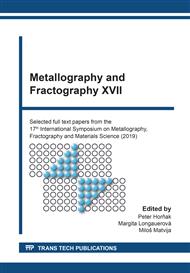p.251
p.259
p.264
p.271
p.277
p.282
p.288
p.294
p.300
Detection of Early Stage of Fatigue Changes in Non-Alloy Steel Using Residual Magnetic Field Method
Abstract:
In this work, the fatigue of P265GH steel acc. to EN 10216-2 has been evaluated by measuring a residual magnetic field (RMF). During experiment the notched-specimen has been loaded with a servo-hydraulic uniaxial MTS test machine and a special magnetic sensor was applied. The measurement distribution of the residual magnetic field was performed in two axes. In the first stage of experiment the specimen was gradually loaded with quasi-static force in range of 0 to 16 kN (~ 0.7 Rm). The increase of strength of residual magnetic field was observed only from 0 to 8 kN, whereas in range 8 to 16 kN this effect was not noticed. In the second stage the controlled tensile fatigue test was performed (R = 0, Fmax = 16 kN). Up to 21k load cycles no changes to residual magnetic field were noticed. At 31k cycles the significant increase of amplitude of strength of residual magnetic field change was observed but visual inspection does not show any visible crack, while at 35k cycles crack was visible. It means that applied methodology allow to find the initiation of crack. The performed observation on SEM showed ductile fatigue of fracture.
Info:
Periodical:
Pages:
277-281
Citation:
Online since:
November 2020
Price:
Сopyright:
© 2020 Trans Tech Publications Ltd. All Rights Reserved
Share:
Citation:


